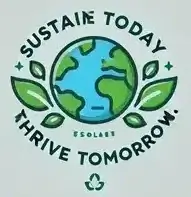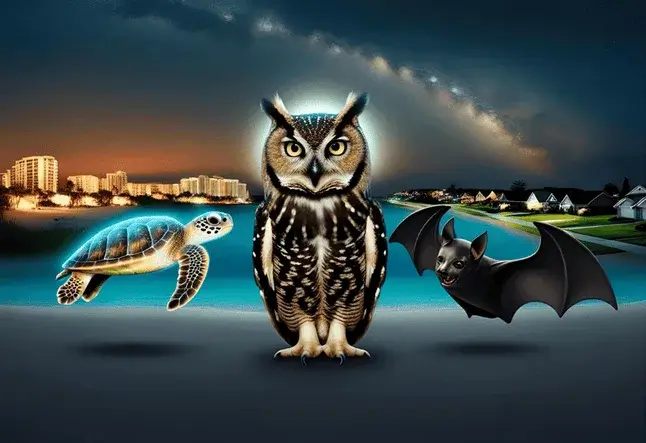Introduction
Light Pollution Drawing with Animals offers a compelling way to spotlight the ecological challenges caused by excessive artificial lighting.
The night sky, once a source of wonder, is increasingly obscured by human-made light.
This environmental issue not only hides the stars but also deeply disrupts the lives of nocturnal animals. More like how thermal pollution affects aquatic ecosystems by altering natural temperature cycles.
Species such as owls, sea turtles, and bats—creatures finely tuned to the rhythms of darkness—are especially vulnerable. Their natural behaviors, like hunting, navigation, and reproduction, are thrown off balance by ever-glowing skies.
Art can play a transformative role in raising awareness. Through evocative drawings, artists can illustrate the hidden consequences of light pollution, turning complex science into emotional storytelling. This article explores creative ideas for artwork highlighting the effects of light pollution on owls, turtles, and bats—each a symbolic guardian of the night and a call to protect our natural darkness.

Table of Contents
Understanding Light Pollution and Its Impact on Wildlife
Before beginning your artistic journey, it’s essential to understand the phenomenon you’re depicting.
Light pollution encompasses several forms of excessive or inappropriate artificial lighting:
- sky glow: the brightening of the night sky over populated areas
- light trespass: light falling where unintended
- glare: excessive brightness causing discomfort
- light clutter: confusing groupings of light sources
Unlike other environmental contaminants, light pollution can be less obvious because humans have adapted to constant illumination. However, for nocturnal wildlife, artificial brightness represents a significant disruption to environments that evolved with natural darkness for millions of years.
If you’re interested in how other forms of pollution disturb wildlife, explore our article on real-world examples of thermal pollution in India—another invisible threat impacting biodiversity and ecosystems.
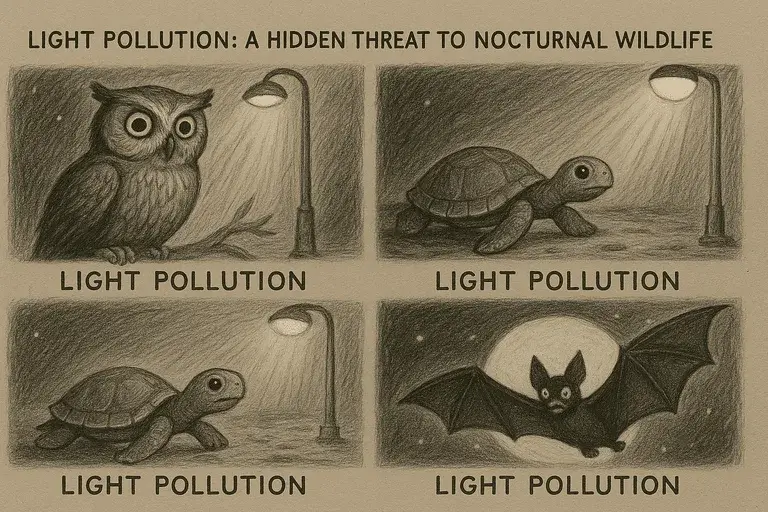
Each affected species faces unique challenges:
Owls have specialized visual and auditory adaptations for hunting in the dark. Excessive artificial light disrupts their hunting patterns, potentially exposing them to predators and interfering with their ability to locate prey. Their highly specialized night vision becomes less advantageous when landscapes are artificially brightened.
Sea turtles display perhaps the most dramatic impact—hatchlings instinctively orient toward the brightest horizon, which historically was moonlight reflecting on ocean waters. Coastal development creates artificial bright horizons that mislead hatchlings inland rather than toward the sea, resulting in disorientation and often death.
Bats face a complex relationship with artificial light, sometimes avoiding illuminated areas (reducing their foraging territory) and sometimes being exploited as easy targets for predators. Light also attracts insects, potentially disrupting local ecosystems and concentrating bat feeding in unnaturally bright areas, creating “ecological traps.”
By understanding these specific impacts, your artwork can tell more compelling visual narratives about these animals’ struggles in our brightening world.
Studies show that artificial light at night (ALAN) can interfere with natural behaviors in many species, including foraging, migration, and reproduction (Longcore & Rich, 2004).
For more educational resources, visit the Royal Astronomical Society’s guide to light pollution.
Essential Art Supplies and Techniques
Creating effective environmental art depicting light pollution requires materials and techniques that capture both nocturnal animals and the contrasting effects of artificial illumination:
Recommended Supplies
- Dark paper (black or deep blue) provides an excellent base for night scenes, making luminous elements stand out dramatically.
- White gel pens, white charcoal, and opaque white paint for stars, moonlight, and highlights
- Colored pencils with layering capabilities for building subtle gradients mimicking light sources
- Soft pastels for atmospheric effects, representing sky glow
- Metallic and fluorescent markers for depicting artificial light sources
- Fine-tipped black pens for defining details like feathers and fur against lighter backgrounds
For digital artists, programs with strong layer effects and glow capabilities (Procreate, Photoshop, GIMP) offer powerful tools for depicting light scenarios.
Light and Shadow Techniques
- Practice reverse drawing by starting with a dark background and gradually adding light.
- Use burnishing with colored pencils to create smooth, luminous areas
- Apply stippling (dots) for gradual transitions between light and shadow
- Try sgraffito (scratching away layers) for star fields or filtered moonlight
For digital art, experiment with layer blending modes like “Screen” or “Color Dodge” to create realistic light effects, and use blur filters to mimic light diffusion in atmospheric conditions.
Creating Contrast
Distinguish between natural and artificial light by:
- Using cooler tones (silver, pale blue, gentle white) for natural light
- Employing warmer or harsher tones (amber, orange, harsh yellow-white) for artificial light
- Considering directionality, natural light often comes from above, while artificial light typically originates from human-level sources.
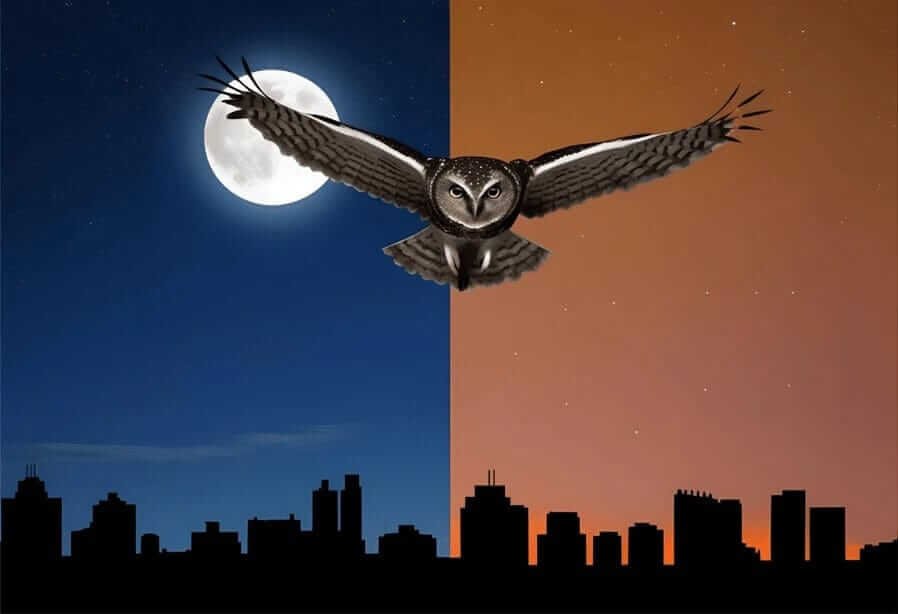
Owl-Inspired Nocturnal Art Concepts
Now that we’ve explored the ecological challenges light pollution poses, let’s explore how we can creatively portray these effects in art. Owls, with their unique nocturnal adaptations, provide an excellent canvas for exploring the intersection of wildlife and artificial light. For more creative ideas on illustrating environmental issues, check out our guide on Air Pollution Drawing for Kids — a fun and easy way to raise awareness through art.
Capturing Adaptations for Night Vision
- Create detailed close-ups of owl eyes, showing one eye adapted to natural darkness and another reflecting harsh artificial light.
- Illustrate normal pupil dilation in darkness versus constriction under artificial light.
- Depict specialized feather structure allowing silent flight—an adaptation less advantageous when prey can visually detect predators under artificial lighting.
Compositional Ideas
- Silhouette Against Light Pollution: Draw an owl in a dark silhouette against a background of city lights and sky glow
- Split Scene: Create a divided composition showing the same landscape with an owl hunting successfully under moonlight on one side and struggling amid artificial lighting on the other
- Hunting Disruption: Design sequential images showing an owl focusing on prey, being blinded by sudden light, and losing its hunting opportunity
- Urban Interface: Illustrate an owl perched on a street lamp, caught between instincts and urban adaptation
Symbolic Elements
Incorporate traditional symbols of wisdom juxtaposed with broken lights, clock elements referencing disrupted circadian rhythms, and partially obscured constellation patterns to symbolize the loss of our celestial heritage.

Sea Turtle Artwork Highlighting Light Pollution
The journey of sea turtle hatchlings provides a dramatic example of light pollution’s impact on wildlife behavior and survival.
Depicting the Hatchling Journey
- Create sequential drawings showing traditional paths hatchlings would follow under natural conditions versus confused wandering under artificial light.
- Illustrate beach scenes from a hatchling’s perspective, where hotel lights dominate instead of moonlight on water.
- Design split compositions showing successful navigation by starlight on pristine beaches, contrasted with disorientation on developed coastlines
Read more from NOAA on how light pollution affects sea turtles.
Coastal Development Effects
- Create panoramic views showing increasing development and light pollution over time, with corresponding changes in nesting success.
- Illustrate differences between turtle-friendly lighting solutions (shielded, low, red-spectrum) and problematic fixtures (bright, white, unshielded). For real-world lighting guidelines, see Florida’s turtle-friendly lighting recommendations.
- Design infographics showing how inland light pollution creates sky glow, affecting coastal environments
- Depict volunteer efforts creating dark corridors during the hatching season.
Conservation Messaging
Incorporate hopeful elements showing how proper lighting modifications can restore natural behaviors, circular journey illustrations emphasizing the multi-generational importance of protecting nesting sites, and successful conservation interventions like artificial moon pools guiding hatchlings to safety.
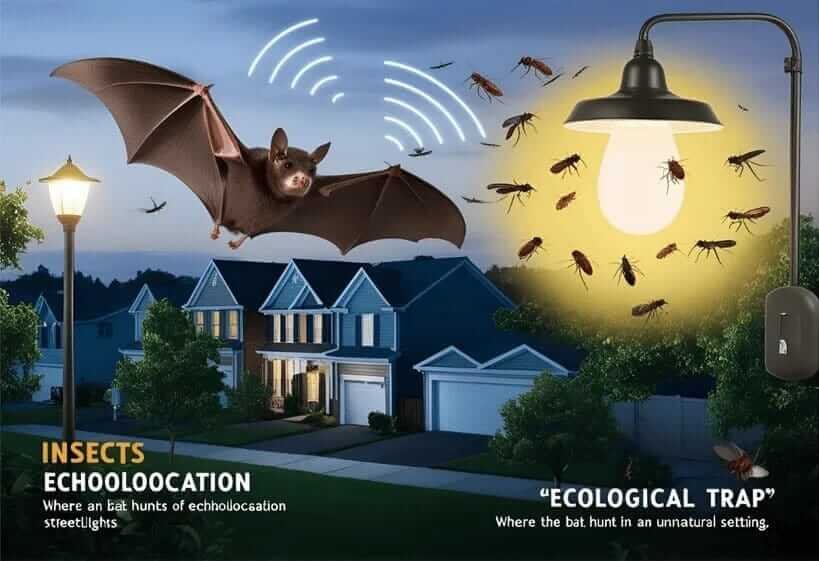
Bat Illustrations and Light Pollution Impacts
Bats’ complex relationship with artificial light makes them fascinating subjects for nuanced environmental artwork.
Research shows that artificial lighting significantly impacts bat behavior in several ways:
- Fragments of bat habitats
- Alter flight patterns
- Reduces foraging efficiency
- Increases predator exposure
(Source: Bat Conservation International)
Capturing Echolocation and Navigation
- Visualize echolocation with sound waves disrupted by artificial light sources
- Design split-frame illustrations showing a bat’s “mental map” under natural darkness versus artificial lighting
- Illustrate changed insect distribution patterns between dark and lit areas
- Depict flight paths avoiding artificially lit areas, showing habitat fragmentation
Urban Settings and Light Interactions
- Create cityscapes showing bats clustered around certain street lights that attract insects, illustrating “ecological trap” phenomena.
- Design contrast pieces showing beneficial bat-friendly lighting versus problematic fixtures
- Illustrate urban roosts with light intrusion problems affecting daytime rest.
- Create sequential art showing how city bats navigate increasingly illuminated landscapes.
Educational Elements
Incorporate visual representations of insect consumption volume, pollination services provided to specific plants, and economic value comparisons to counter common misconceptions about bats.
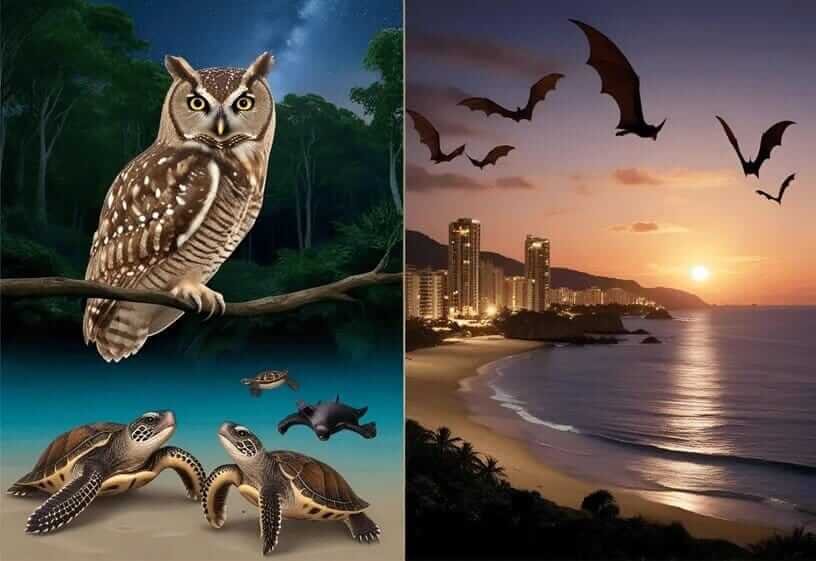
Creating Mixed Animal Compositions
Combining multiple light pollution-affected species in a single artwork tells more complex ecological stories about interconnected impacts.
Ecosystem-Based Approaches
- Design vertical habitat slices showing light effects across canopy layers, from owls to mid-level bats to ground-dwelling creatures.
- Create watershed perspectives following the light’s impact from inland areas to coastal nesting beaches.
- Illustrate food webs where artificial light disrupts various connections between species.
- Design seasonal cycles showing different challenges throughout the year
Storytelling Through Sequential Art
- Create historical timelines showing the same landscape at different development stages.
- Design day-to-night transition scenes showing animal emergence or retreat as artificial lighting increases
- Illustrate solution scenarios where lighting improvements restore wildlife presence.
- Create migration stories showing celestial navigation increasingly obscured by sky glow.
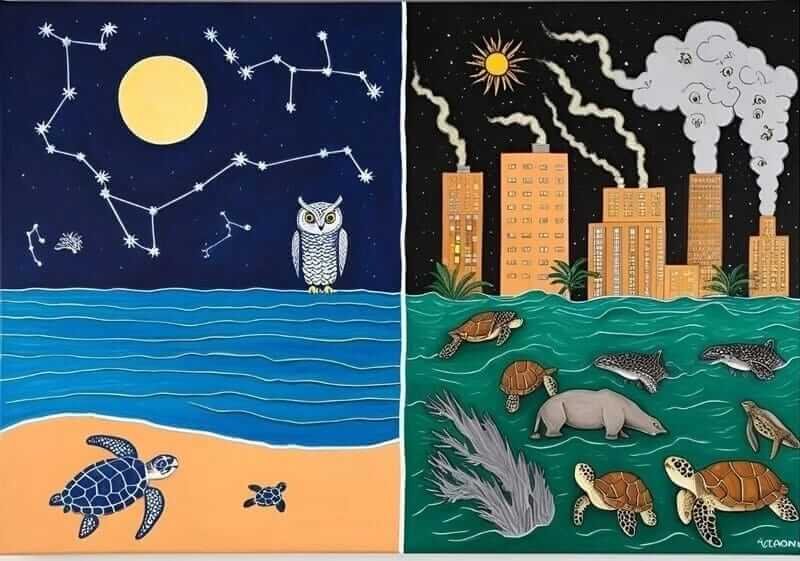
Practical Applications and Community Engagement
Your light pollution artwork can become a powerful tool for education and advocacy beyond personal expression.
Educational Projects
- Design step-by-step drawing guides combining art instruction with environmental education
- Create coloring pages showing proper versus improper lighting scenarios
- Develop comparison cards showing animals under natural versus artificial conditions
- Design infographic posters explaining the impacts on local wildlife
Community Art and Advocacy
- Propose mural concepts focusing on local nocturnal wildlife
- Create light projection art for community dark sky events
- Develop informational postcards for distribution at community events
- Design interpretive trail signage incorporating wildlife artwork
More than 80% of the world’s population now lives under light-polluted skies, according to the 2016 World Atlas of Artificial Night Sky Brightness (Falchi et al., 2016).
Digital Sharing
- Create shareable infographics about specific species’ impacts
- Design before/after slider images showing scenes with and without light pollution
- Develop a series of related pieces for sustained awareness campaigns
- Consider simple animations demonstrating effects for video platforms
Conclusion
Art makes the invisible visible, turning abstract concepts into emotional realities.
Light pollution drawings featuring owls, turtles, and bats harness creative power to paradoxically illuminate the importance of darkness in our natural world.
By depicting these sentinel species and their struggles with artificial light, artists become advocates for both wildlife conservation and preserving our connection to the night sky.
Each drawing becomes environmental communication with the power to change perspectives and behaviors.
Learn more about why dark skies are essential for both animals and people.
The solutions to light pollution—better-designed fixtures, appropriate timing controls, thoughtful placement, and warmer color temperatures—are readily available and often cost-effective. Your artwork can help visualize both problems and possibilities, illuminating a path toward nightscapes where wildlife and humans thrive under naturally dark, star-filled skies.
What will you create to help others see the importance of natural darkness? How might your art inspire changes that benefit silent-hunting owls, ocean-bound turtle hatchlings, and echo-navigating bats? The canvas awaits your vision.
Ready to share your light pollution artwork? Connect with local astronomy clubs, wildlife centers, or the International Dark-Sky Association to find communities dedicated to preserving our natural night. Learn more at the International Dark-Sky Association, the global leader in light pollution awareness and solutions.
Download the Free Light Pollution Drawing with Animals: Ideas Featuring Owls, Turtles & Bats infographic visuals.
Frequently Asked Questions (FAQ)
Q. What is light pollution, and how does it affect animals?
A. Light pollution refers to excessive or misdirected artificial light that disrupts natural darkness. It interferes with the behaviors of nocturnal animals like owls, sea turtles, and bats, impacting their hunting, navigation, and reproduction.
Q. Why are owls vulnerable to light pollution?
A. Owls rely on their exceptional night vision and silent flight to hunt in the dark. Artificial lighting disrupts their ability to see and hear prey effectively, reduces hunting success, and increases exposure to predators.
Q. How does light pollution harm sea turtle hatchlings?
A. Hatchling sea turtles instinctively move toward the brightest horizon, which used to be the moonlit ocean. Artificial coastal lights mislead them inland, often resulting in death from dehydration, predators, or human activity.
Q. What artistic techniques can be used to illustrate light pollution?
A. Artists can use dark paper, white gel pens, and colored pencils to create contrast between natural and artificial light. Techniques like reverse drawing, stippling, and digital glow effects help depict the impact on nocturnal wildlife.
Q. Can art help raise awareness about light pollution?
A. Yes! Artistic storytelling can turn complex ecological issues into emotionally engaging visuals. Drawings featuring affected animals can educate the public and inspire conservation actions.
Q. What are some solutions to reduce light pollution?
A. Effective solutions include using shielded light fixtures, installing motion sensors, choosing warmer color temperatures, and reducing unnecessary lighting, especially near wildlife habitats.
Want to learn more about Light Pollution Drawing?
- Disturbing Light Pollution: Drawing Truths That Will Haunt You →
- How to Make a Light Pollution Drawing for a School Project (Step-by-Step Guide)
- Top 5 Light Pollution Drawing Messages for Students & Artists: Raise Awareness with Art
- Dark Sky Movement Explained Through Light Pollution Drawings: →
About the Author
Soumen Chakraborty is an environmental writer who is passionate about sustainable solutions. He has researched and written about environmental issues for two years, breaking down complex topics into practical, actionable insights.
“Every small action matters in protecting our planet.”
Quick Poll: Which Animal Should We Draw Next?
We’re planning our next light pollution drawing guide—and your vote matters! Which nocturnal animal would you love to see featured?
Hedgehog
Barn Owl
Fruit Bat
Nocturnal Lizard
Raccoon
Vote now in the comments or on our Instagram story @DarkSkyArt!
Or email your suggestions to: ecoplanet@greenglobe25.in
Download the PDF Free Light Pollution Drawing with Animals: Ideas Featuring Owls, Turtles & Bats
Want to reinforce your learning or use it in the classroom? Grab our free downloadable pack that includes:
Test your knowledge with our fun Free Light Pollution Drawing with Animals: Ideas Featuring Owls, Turtles & Bats awareness quiz PDF.
Challenge yourself and see how much you’ve learned about owls, turtles, bats, and the night sky!
